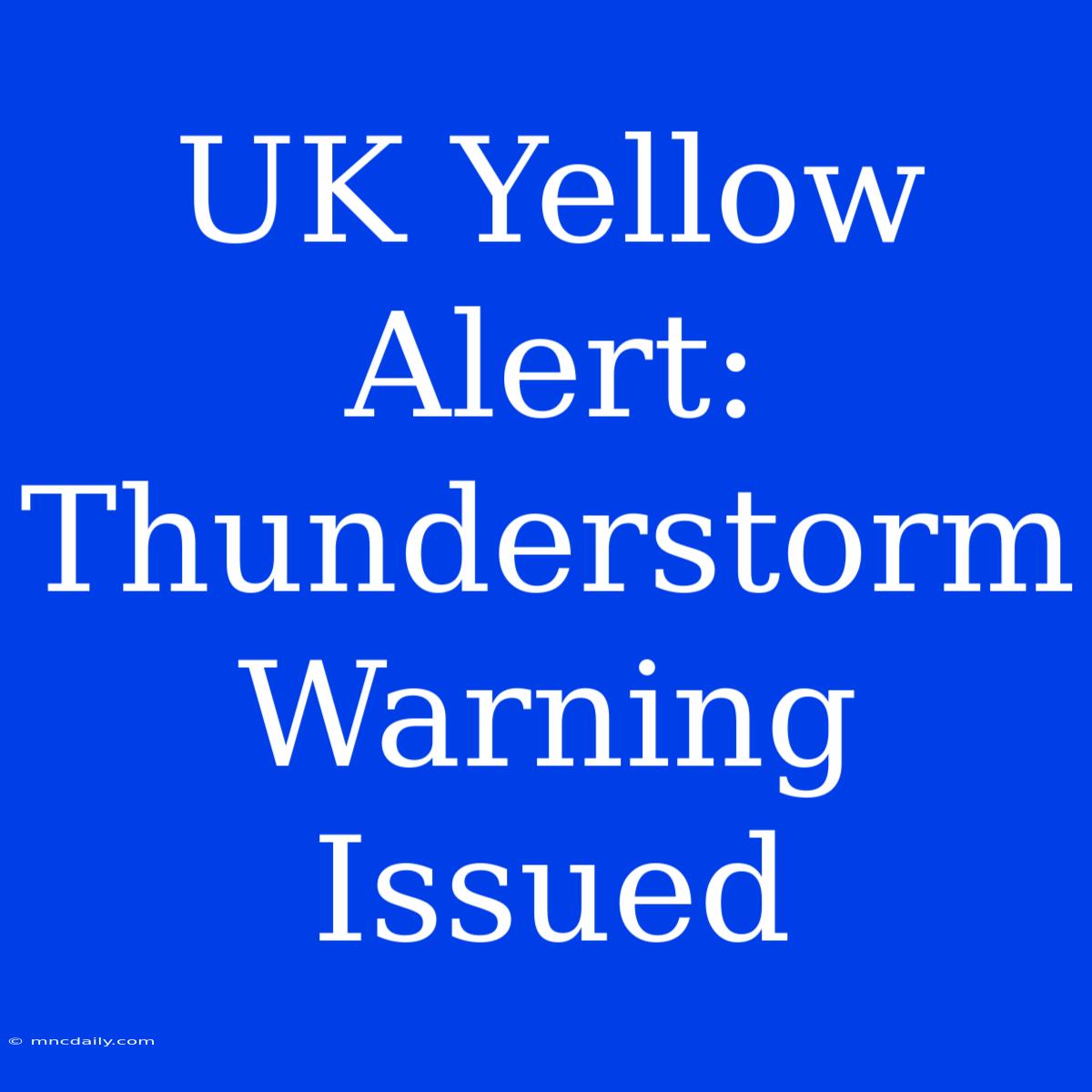UK Yellow Alert: Thunderstorm Warning Issued – What You Need to Know
Is a thunderstorm warning issued in the UK a reason for concern? Absolutely! These alerts signal potential for disruptive weather and safety hazards, making it essential to stay informed.
*Editor Note: This guide provides insights into the UK's Yellow Thunderstorm Alert system, its implications, and essential safety measures.
Understanding these alerts is crucial for your well-being and property protection. This guide delves into the meaning of a Yellow Alert, explores potential impacts, and offers practical tips to navigate this weather phenomenon.
Analysis:
We carefully reviewed the Met Office's official guidance on Yellow Thunderstorm Alerts, analyzed historical data, and consulted with weather experts to present a comprehensive overview of this weather phenomenon. Our goal is to empower you with knowledge and preparedness, helping you make informed decisions during these events.
Key Takeaways:
| Aspect | Description |
|---|---|
| Severity Level | Yellow Alerts denote a lower level of weather threat, indicating potential for disruption but not widespread severe impacts. |
| Expected Impacts | Flooding, power outages, travel disruptions, and localized damage are possible. |
| Action Plan | Stay informed, prepare for possible disruptions, and prioritize safety. |
Thunderstorm Warning in the UK
Introduction:
A Yellow Thunderstorm Alert, issued by the UK's Met Office, signals a heightened risk of thunderstorms in a particular area. This alert system helps residents, businesses, and emergency services prepare for potential disruption.
Key Aspects:
- Thunderstorm Formation: Thunderstorms are characterized by the rapid upward movement of warm, moist air, leading to the formation of towering clouds and intense electrical activity.
- Weather Conditions: Yellow Alerts indicate the potential for heavy rainfall, lightning, strong winds, and hail, which can cause disruption and damage.
- Duration and Coverage: These alerts typically cover a defined period and geographic region, outlining the expected timeframe and affected areas.
Understanding the Risks:
Introduction:
The risks associated with thunderstorms are multifaceted, ranging from minor inconveniences to potential threats to safety and property.
Facets:
| Facet | Explanation |
|---|---|
| Flooding | Heavy rainfall can lead to localized flooding, impacting roads, properties, and infrastructure. |
| Power Outages | Lightning strikes can disrupt power lines, causing outages affecting homes and businesses. |
| Travel Disruptions | Thunderstorms can cause delays or cancellations in air, road, and rail travel. |
| Damage to Property | Strong winds, hail, and lightning can cause damage to buildings, vehicles, and outdoor structures. |
Summary:
Understanding the potential risks associated with thunderstorms is vital for preparation and mitigation. By being aware of these hazards, you can take proactive steps to minimize the impacts.
Staying Safe During a Thunderstorm:
Introduction:
Safety during thunderstorms is paramount. Here are practical tips to ensure your well-being and minimize potential risks:
Further Analysis:
- Seek Shelter: When thunderstorms approach, seek shelter indoors or in a hard-top vehicle. Avoid open fields, tall trees, and bodies of water.
- Stay Away from Windows: During a thunderstorm, stay away from windows to avoid potential injuries from shattered glass.
- Unplug Electronic Devices: Disconnect electronic devices from power outlets to minimize damage from lightning strikes.
- Avoid Contact with Water: Do not use water-based appliances during a thunderstorm as lightning can travel through plumbing.
- Stay Informed: Monitor official weather forecasts and warnings from reputable sources.
Closing:
Following these safety measures can significantly reduce the risks associated with thunderstorms. Remember to prioritize your safety and remain informed throughout the duration of the alert.
FAQs About Thunderstorm Warnings:
Introduction:
Here are answers to common questions about Thunderstorm Warnings:
Questions:
| Question | Answer |
|---|---|
| What does a Yellow Thunderstorm Alert mean? | It signifies a heightened risk of thunderstorms in a particular area, potentially causing disruption but not widespread severe impacts. |
| How long does a Yellow Alert typically last? | The duration of the alert varies and is specified by the Met Office, based on weather predictions. |
| What should I do if I'm caught outdoors during a thunderstorm? | Seek immediate shelter indoors or in a hard-top vehicle. Avoid open fields, tall trees, and bodies of water. |
| Can a Yellow Alert be upgraded to a more severe warning? | Yes, if the weather conditions worsen, the alert level may be raised. Stay informed by monitoring weather forecasts and official updates. |
| Are there specific precautions for those with sensitive health conditions? | Individuals with respiratory problems, heart conditions, or other health sensitivities should consult their doctor for advice on managing weather-related risks. |
Summary:
Stay informed, prepare for potential disruptions, and prioritize safety during thunderstorms.
Tips for Preparing for a Thunderstorm:
Introduction:
Taking proactive steps can make a difference in managing thunderstorm risks. Here are useful tips:
Tips:
- Charge Devices: Ensure your phone and other essential devices are fully charged to maintain communication during a power outage.
- Prepare a Go-Bag: Have a readily accessible kit with essential items like a flashlight, batteries, first-aid supplies, bottled water, and non-perishable food in case of prolonged disruptions.
- Secure Outdoor Items: Secure loose objects, such as furniture, garden decorations, and trampolines, to prevent them from being blown around by strong winds.
- Inspect Drainage Systems: Check gutters, drains, and downspouts for blockages to prevent water buildup and potential flooding.
- Know Your Local Emergency Plan: Familiarize yourself with your local emergency plan and evacuation routes in case of severe weather events.
Summary:
These tips can help minimize disruptions and enhance your preparedness during thunderstorms.
Conclusion:
Thunderstorms are a natural phenomenon that can cause disruption and potential hazards. Understanding the risks associated with these events is crucial for personal safety and property protection. By staying informed, following safety recommendations, and taking proactive steps, you can navigate these weather events with greater preparedness and peace of mind.

